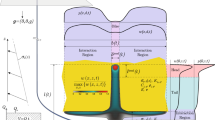Abstract
An algorithm is presented for inverting either laboratory or field poroelastic data for all the drained constants of an anisotropic (specifically orthotropic) fractured poroelastic system. While fractures normally weaken the system by increasing the mechanical compliance, any liquids present in these fractures are expected to increase the stiffness somewhat, thus negating to some extent the mechanical weakening influence of the fractures themselves. The analysis presented in this article quantifies these effects and shows that the key physical variable needed to account for the pore-fluid effects is a factor of (1 − B), where B is Skempton’s second coefficient and satisfies 0 ≤ B < 1. This scalar factor uniformly reduces the increase in compliance due to the presence of communicating fractures, thereby stiffening the fractured composite medium by a predictable amount. One further aim of the discussion is to determine the number of the poroelastic constants that needs to be known by other means to determine the rest from remote measurements, such as seismic wave propagation data in the field. Quantitative examples arising in the analysis show that, if the fracture aspect ratio \({a_f \simeq 0.1}\) and the pore fluid is liquid water, then for several cases considered, Skempton’s \({B \simeq 0.9}\), and so the stiffening effect of the pore-liquid reduces the change in compliance due to the fractures by a factor \({1 - B \simeq 0.1}\), in these examples. The results do, however, depend on the actual moduli of the unfractured elastic material, as well as on the pore-liquid bulk modulus, so these quantitative predictions are just examples, and should not be treated as universal results. Attention is also given to two previously unremarked poroelastic identities, both being useful variants of Gassmann’s equations for homogeneous—but anisotropic—poroelasticity. Relationships to Skempton’s analysis of saturated soils are also noted. The article concludes with a discussion of alternative methods of analyzing and quantifying fluid-substitution behavior in poroelastic systems, especially for those systems having heterogeneous constitution.
Similar content being viewed by others
References
Berryman J.G.: Transversely isotropic poroelasticity arising from thin isotropic layers. In: Golden, K.M., Grimmett, G.R., James, R.D., Milton, G.W., Sen, P.N. (eds) Mathematics of Multiscale Materials, pp. 37–50. Springer-Verlag, New York (1998)
Berryman J.G.: Seismic waves in rocks with fluids and fractures. Geophys. J. Int. 171, 954–974 (2007)
Berryman J.G., Grechka V.: Random polycrystals of grains containing cracks: Model of quasistatic elastic behavior for fractured systems. J. Appl. Phys. 100, 113–527 (2006)
Berryman J.G., Milton G.W.: Exact results for generalized Gassmann’s equations in composite porous media with two constituents. Geophysics 56, 1950–1960 (1991)
Berryman J.G., Nakagawa S.: Inverse problem in anisotropic poroelasticity: Drained constants from undrained ultrasound measurements. J. Acoustical Soc. Am. 127, 720–729 (2010)
Berryman J.G., Wang H.F.: The elastic coefficients of double-porosity models for fluid transport in jointed rock. J. Geophys. Res. 100, 24611–24627 (1995)
Biot M.A., Willis D.G.: The elastic coefficients of the theory of consolidation. J. Appl. Mech. 24, 594–601 (1957)
Bristow J.: Microcracks, and the static dynamic elastic constants of annealed and heavily cold-worked metals. Br. J. Appl. Phys. 11, 81–85 (1960)
Brown R.J.S., Korringa J.: On the dependence of the elastic properties of a porous rock on the compressiblity of the pore fluid. Geophysics 40, 608–616 (1975)
Budiansky B., O’Connell R.J.: Elastic moduli of a cracked solid. Int. J. Solids Struct. 12, 81–97 (1976)
Gassmann F.: Über die Elastizität poröser Medien. Vierteljahrsschrift der Naturforschenden Gesellschaft in Zürich 96, 1–23 (1951)
Hashin Z., Shtrikman S.: A variational approach to the theory of the elastic behavior of multiphase materials. J. Mech. Phys. Solids 11, 127–140 (1963)
Hill R.: Elastic properties of reinforced solids: Some theoretical principles. Proc. Phys. Soc. London A 65, 349–354 (1952)
Mavko G., Mukerji T., Dvorkin J.: The Rock physics handbook: tools for seismic analysis of porous media, 2nd edn. Cambridge University Press, Cambridge (2009)
Reuss A.: Berechung der Fließgrenze von Mischkristallen auf Grund der Plastizitätsbedingung für Einkristalle. Z Angew Math Mech 9, 49–58 (1929)
Sayers C.M., Kachanov M.: A simple technique for finding effective elastic constants of cracked solids for arbitrary crack orientation statistics. Int. J. Solids Struct. 27, 671–680 (1991)
Sayers C.M., Kachanov M.: Microcrack-induced elastic wave anisotropy of brittle rocks. J. Geophys. Res. 100, 4149–4156 (1995)
Skempton A.W.: Coherent-potential model of substitutional alloys. Géotechnique 4, 143–147 (1954)
Thomsen L.: Understanding Seismic Anisotropy in Exploration and Exploitation. Society of Exploration Geophysicists, Tulsa (2002)
Voigt W.: Lehrbuch der Kristallphysik. Teubner, Leipzig (1928)
Wood A.W.: A Textbook of Sound. Bell, London (1948)
Zhu, X., McMechan, G.A.: Direct estimation of the bulk modulus of the frame in a fluid-saturated elastic medium by Biot theory. In: 60th International Meeting, Society of Exploration Geophysicists, p. 787 (1990)
Author information
Authors and Affiliations
Corresponding author
Rights and permissions
About this article
Cite this article
Berryman, J.G. Poroelastic Response of Orthotropic Fractured Porous Media. Transp Porous Med 93, 293–307 (2012). https://doi.org/10.1007/s11242-011-9922-7
Received:
Accepted:
Published:
Issue Date:
DOI: https://doi.org/10.1007/s11242-011-9922-7




